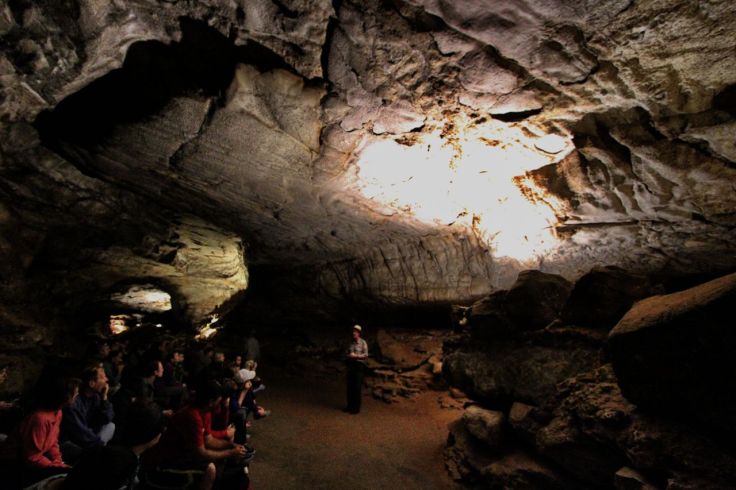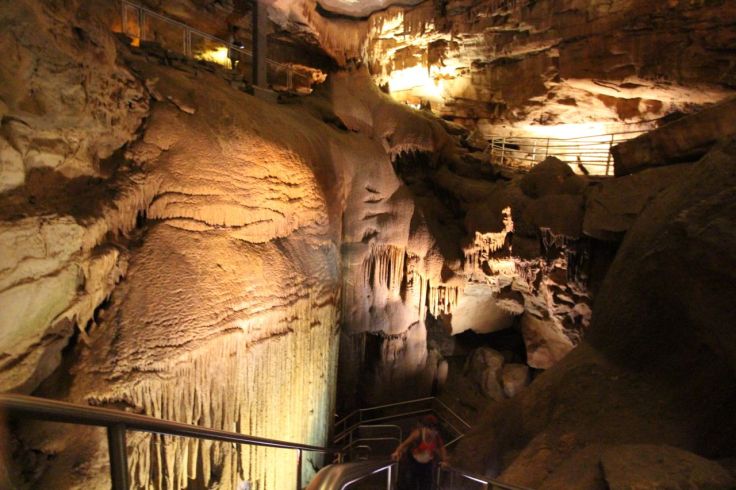Although our travel plans were going to be largely confined to Tennessee, how could my wife and I not pass up Mammoth Cave National Park in South Central Kentucky? The first I ever heard of it was during a nature program on PBS, described as the largest cave system in the world. Its size is so immense that it would still be larger than the next two largest systems combined by 100 miles.
Odd that the name uses the grammatical singular when in fact Mammoth Cave is comprised of many interconnected spaces in the limestone: sink holes, tubes, passageways, canyons, shafts, fissures as well as caves. This combination of limestone and excavation is characteristic of karst. A geology map shows that almost a quarter of Kentucky is karstic.
Mammoth was our first overnight stop after picking up a car at Nashville Airport and driving two hours north. The park is surrounded by the famous rolling hills of Kentucky. As we got closer, the road cuts in some areas bared telltale limestone layers. The soil has a rusty-reddish color.
We checked in to the Mammoth Cave Hotel, located within the national park boundary. Our accommodation was a standalone cabin, one of ten that form an arc along the property’s edge, which was rustic but comfortable. The hotel was undergoing an extensive renovation and construction until November, so the main building and eating facilities were closed behind chain-link fencing, except for the outlying cabins. In the evening, there was the musical thrum of cicadas and tree frogs. The park’s visitors center is only a short walking distance away.
On our only full day here, we wanted to maximize our cave experience. To that end we decided to take the longest tour called Grand Avenue tour. At almost 400 surveyed miles and counting, Mammoth was not going to feel as if we had trod on it at all. We had a terrific guide in ranger Rick Thomas, who was so knowledgeable about the cave and its history, told interesting stories and cracked bad jokes (“There’s nothing lower than cave humor,” he said proudly). As a federal employee, he was obliged to forewarn everyone on the tour, all 69 of us, that the fast-paced walk of roughly four hours, four miles and almost 700 steps over uneven terrain would be taxing. He also had to mention that in an emergency, it would take a very long time to get anyone to a hospital. No one budged. The last time my wife and I were ‘intimidated’ by a park employee (the Fiery Furnace walk at Arches National Park), we to this day regretted having changed our minds. Not this time.
The usual speleotherms of stalactites, stalagmites and such, of wet cave environments were scarce, but there were plenty of gypsum accumulations (in the form of blisters and flowers) typical of dry caves, compliments of a hard layer of sandstone that acts like an almost impervious cap over the limestone underneath. These gypsum deposits are unimaginably slow growing at a rate of a dime’s thickness per century. One impressive example is Last Rose of Summer along Cleveland Avenue. There are prolific gypsum blisters in The Snowball Room, because they look like snowballs on the ceilings and walls.


The long tour passage was the result of underground streams and rivers that have long since drained into the Green River, which over a period of time has carved ever deeper into the limestone layers, leaving the upper limestone layers dry. Parts of the tour were like walking through a long elliptical tunnel, sometimes bordered by smooth walls or flat ceilings, other times littered with limestone fragments, including huge slabs lying at oblique angles. Other sections were like underground slot canyons, at several points narrow enough that you had to angle your body to get through, an experience not unlike in the Southwest. We had to walk single-file for roughly a mile. There were also cavernous rooms where the group could gather around Ranger Rick to hear another story or lecture. At tour’s end, we got to see the spectacular Frozen Niagara, an unbelievable mass of flowstone deposits that require a steep descent of some forty stairs to see top to bottom. Looking up from the pit gives you a view of why this area was so named. It looks like frozen water cascading over an enormous U-shaped ledge (top image).



As it turned out, the tour really was exhausting like Rick warned. We were bushed by its end, but what an experience!
Mammoth Cave National Park
1 Mammoth Cave Pkwy
Mammoth Cave, KY 42259
270. 758.2180

Leave a comment